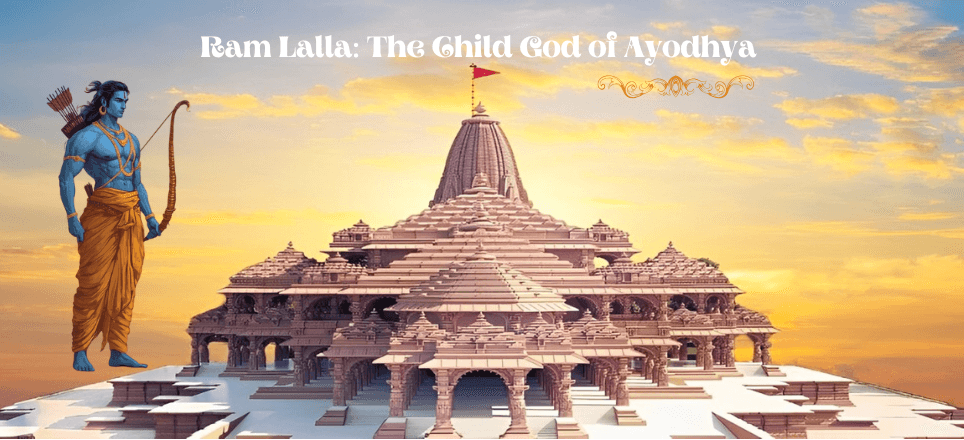No products in the cart.

Who is Ram Lalla?
Ram Lalla, literally meaning “Baby Ram,” refers to the divine child form of Lord Rama, an incarnation of Lord Vishnu. Worshipped by millions of Hindus, Ram Lalla holds a unique place in the hearts of devotees. This form signifies not only the birth of a deity but also the virtues of innocence, purity, and divine grace. The young Lord Rama, or Ram Lalla, is revered especially in Ayodhya, his birthplace, which is one of the holiest cities in Hinduism. But what makes Ram Lalla so important, and how did this sacred image become the focus of such deep devotion and historical significance?
The Significance of Ram Lalla in Hinduism
Ram Lalla’s Role in the Ramayana
In the epic of the Ramayana, Ram Lalla represents the divine childhood of Lord Rama. This phase of his life is seen as the origin of all the qualities Lord Rama would later embody – righteousness, bravery, and devotion to duty. For Hindus, Ram Lalla is a direct connection to the divine. Worshipping the child form brings out a sense of closeness to the god, as if one were nurturing the god himself. The adorable and approachable form of Ram Lalla allows devotees to feel a familial connection to the divine.
The Child Form of Lord Rama
The childlike form of a god always invokes tender devotion, and Ram Lalla is no different. Much like how Krishna is adored as “Bal Gopal” (Baby Krishna), Ram Lalla’s child form emphasizes vulnerability, divinity, and human-like qualities, making it easier for devotees to connect personally. By focusing on the child form, worshippers offer their love and care to Ram Lalla, celebrating the divine innocence that later grows into a righteous warrior king. This is why Ram Lalla worship is so central to the Hindu faith.
History of Ram Lalla in Ayodhya
Ram Lalla’s Deep Roots in Ayodhya
Ayodhya and Ram Lalla are inseparable in the Hindu religious consciousness. As the birthplace of Lord Rama, Ayodhya has been central to Hindu devotion for millennia. Ram Lalla, the child deity, has long been associated with the Ram Janmabhoomi (birthplace of Lord Rama), and devotees flock from all corners of the globe to pay respects to the divine child. Ram Lalla represents the spiritual essence of Ayodhya, an ancient city that embodies the soul of Hinduism.
The Discovery of Ram Lalla Idol in 1949
The journey of Ram Lalla from spiritual lore to the center of modern religious discourse began in 1949, when the idol of Ram Lalla was found inside the Babri Masjid. This discovery sparked a renewed fervor among Hindus, who believed that the spot where the idol appeared was indeed the birthplace of Lord Rama. As news of the appearance of Ram Lalla spread, it reignited ancient devotion and brought Ram Lalla to the forefront of one of India’s longest and most contentious religious disputes.
The Ram Janmabhoomi-Babri Masjid Dispute
Origins of the Dispute Around Ram Lalla
The Ram Janmabhoomi-Babri Masjid dispute is one of the most significant religious and political conflicts in India, and at its heart is Ram Lalla. The dispute centers around whether the site where the Babri Masjid stood was indeed the birthplace of Ram Lalla. For Hindus, this site is sacred, as it is believed to be where Ram Lalla was born. This claim has persisted for centuries, and Ram Lalla has become not only a religious figure but a symbol of cultural identity for millions of Hindus.
Ram Lalla Virajman: Legal Battles for the Divine Child
Ram Lalla Virajman, the legal entity of Ram Lalla, became a focal point in the long-standing court battles over the Ayodhya site. What makes this particularly unique is that Ram Lalla was recognized by the Indian judiciary as a juristic person, which allowed him to be part of legal proceedings. This gave Ram Lalla a voice in court, as the deity itself became a party in the legal fight over the Ram Janmabhoomi. The case, with Ram Lalla at its center, went through several legal twists and turns, eventually leading to the historic Supreme Court judgment in 2019.
Ram Lalla Virajman: A Legal Deity
Ram Lalla: A Recognized Legal Entity
The legal recognition of Ram Lalla as a juristic person is unprecedented in Indian history. This legal status allowed Ram Lalla Virajman to claim ownership of the disputed land. Recognizing a deity as a legal entity reflects the importance of Ram Lalla in the Indian legal system and in the hearts of millions of devotees. It speaks to the unique status that Ram Lalla holds in Indian culture, being not just a spiritual figure but also a key participant in a complex legal and political saga.
The Supreme Court Verdict: Victory for Ram Lalla
The 2019 Supreme Court verdict in favor of building the Ram Mandir at the Ram Janmabhoomi site was a momentous occasion for the devotees of Ram Lalla. This decision was seen as a triumph for the divine child, as the land where Ram Lalla resided was officially granted for the construction of a grand temple in his honor. The verdict underscored the significance of Ram Lalla in the collective faith of the nation and marked the beginning of a new chapter in the history of Ayodhya.
The Construction of the Ram Mandir: Home of Ram Lalla
Ram Lalla’s Future Abode: The Grand Ram Mandir
The construction of the grand Ram Mandir is more than just a building project — it is seen as the manifestation of centuries of devotion to Ram Lalla. The temple, once completed, will be a monumental tribute to the child form of Lord Rama. Ram Lalla will finally reside in a temple built on what devotees consider his sacred birthplace, bringing a sense of fulfillment to millions of Hindus who have long awaited this moment.
The Groundbreaking Ceremony and Spiritual Significance
In 2020, the groundbreaking ceremony for the Ram Mandir took place, with Prime Minister Narendra Modi performing rituals in the presence of religious leaders. The image of Ram Lalla at the center of this event highlighted the emotional and spiritual significance of the temple for Hindus around the world. The temple is seen as Ram Lalla’s rightful home, and its construction is imbued with deep religious meaning.
Devotional Practices Around Ram Lalla
How Devotees Worship Ram Lalla
For millions of devotees, offering prayers to Ram Lalla is a deeply personal spiritual act. The child form of Lord Rama is worshipped with affection and care, with offerings of sweets, flowers, and toys symbolizing the innocence of Ram Lalla. Temples dedicated to Ram Lalla often see devotees reciting verses from the Ramayana, singing hymns, and engaging in prayers that connect them with the divine child.
Celebrating Ram Navami in Honor of Ram Lalla
Ram Navami, the festival celebrating the birth of Ram Lalla, is a major event in Ayodhya. Each year, thousands of devotees gather to honor the divine child, with grand processions and religious ceremonies marking the occasion. The festival is a reflection of the enduring connection between Ram Lalla and the devotees who revere him as the embodiment of purity and righteousness.
Ram Lalla’s Symbolism in Modern India
Ram Lalla: A Unifying Symbol of Devotion
In today’s India, Ram Lalla stands as a symbol of faith, resilience, and unity. Despite the many challenges and disputes surrounding the Ram Janmabhoomi, the image of Ram Lalla has remained a powerful force for Hindus, representing the enduring values of righteousness and justice. For many, Ram Lalla is a reminder that faith can withstand the test of time.
Conclusion
The story of Ram Lalla is not just one of devotion; it’s a narrative of faith, identity, and perseverance. From his divine presence in Ayodhya to becoming a central figure in one of India’s most important religious and legal disputes, Ram Lalla continues to inspire millions. His child form invites worshippers to experience the divine in its most innocent and purest form, making Ram Lalla one of the most cherished deities in Hinduism.
FAQs
What is Ram Lalla’s significance in Hinduism?
Ram Lalla represents the child form of Lord Rama, symbolizing innocence, purity, and divine grace. His worship is an important part of Hindu religious practice.
Why is Ayodhya important for Ram Lalla?
Ayodhya is considered the birthplace of Ram Lalla, making it one of the most sacred cities for Hindus.
What is the current status of the Ram Mandir for Ram Lalla?
The construction of the Ram Mandir, which will be the future abode of Ram Lalla, is underway and is expected to be completed soon.
What legal battles surrounded Ram Lalla?
Ram Lalla was a central figure in the Ram Janmabhoomi dispute, with the Indian court recognizing him as a legal entity in the case regarding the ownership of the disputed land.
How can one visit Ram Lalla in Ayodhya?
Devotees can visit Ram Lalla at the makeshift temple in Ayodhya until the completion of the Ram Mandir, which will serve as the permanent home of the deity.








Add comment